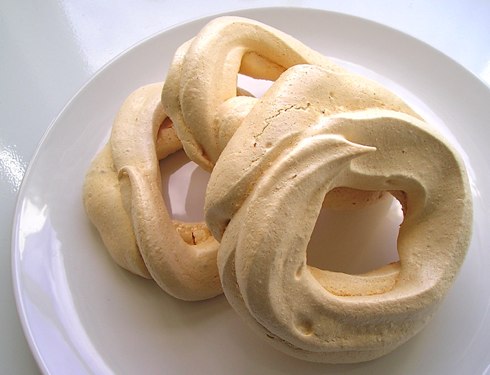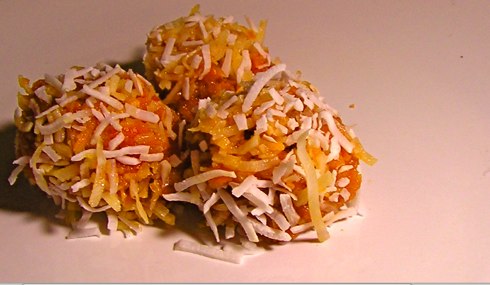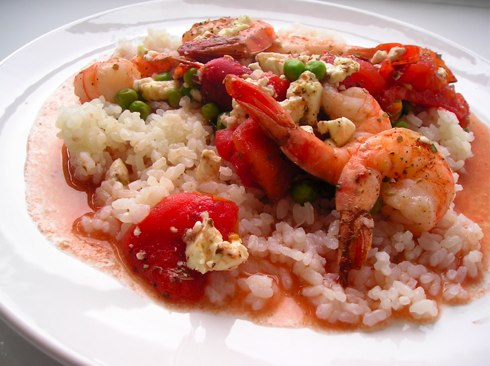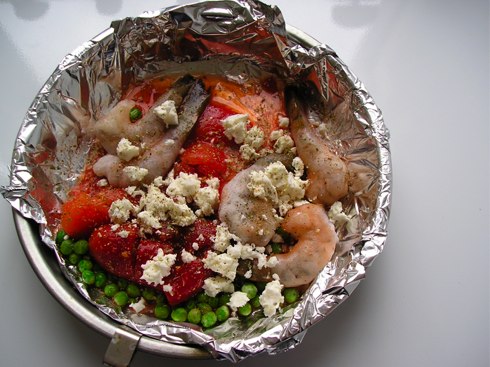by Sam Tackeff | Feb 26, 2009 | Baking, Barefoot Blogging, Challenge

A few weeks ago, I discovered Barefoot Bloggers, a group of people who love Ina Garten, the Barefoot Contessa, just as much as I do, and who have joined together to cook through her marvelous recipes. The next recipe on the list was Ina’s Meringues Chantilly, chosen by BMK of Reservations Not Required Fantastic! I love meringues! But the question was, would it be possible to make it in my kitchen in time to post today? You see, there are rules about meringue. Fresh eggs! Metal bowl! Only on a sunny dry day! That was the one I was the most worried about…. this is San Francisco… a sunny dry day? Oh dear.
I scanned the recipe list.
My first challenge: Cream of Tartar. Hmmm.. I’ve always had cream of tartar lying around, but now I don’t have any in my new kitchen. So began the search for cream of tartar. Apparently, it’s not really something that you just buy here. Four stores later, I finally found some overpriced cream of tartar and bought it. There is nothing like spending six dollars for something you are going to use a quarter teaspoon of. Sigh.
The next part was the eggs. According to the experts, you need the freshest eggs, to help break down the protein in the whipping process. I got mine from Omnivore Books on Food, where Celia, the owner sells fresh eggs from her neighbor’s farm in addition to her well chosen selection of cook books and books on food. These eggs are the absolute best, with really big orange yolks (which because they were omitted from this recipe are about to end up in a custard).
Now for a metal bowl. I didn’t have a metal bowl, but I had a glass pyrex. Would this work well enough? According to the experts, glass should work fine- the key is not to use plastic, because the fat from previous cooking might stick to it and ruin your meringue.
Finally, Ina’s recipe called for orange liqueur, and framboise, a raspberry liqueur, although all the hard liquor I had in my house is… Seagrams Whiskey. I know. I was the queen of the liquor cabinet. Four years of collecting the finest alcoholic libations in my dorm room, and all I have now is a bottle of whiskey, in a plastic jug no less. Because my current priority is paying my rent rather than paying for the expansion of my liquor cabinet, I opted to substitute the whiskey.
Finally I was ready to make the meringues.
…And it rained hard, down pouring rain for three days. I just couldn’t do it. The experts tell you to avoid moisture- not even to run your dishwasher or boil a kettle!
Just two days ago, the sun broke through the clouds and I was prepared to make the recipe. I went to the cabinet and…. apparently we didn’t have a hand held mixer. How could I forget! Oh god, I’ve whisked meringue before, and it’s a long, arduous process with no real assurance that they will even stiffen into peaks. A quick panic led to the obvious thought- I live in an apartment building now! I could borrow a mixer!! Huzzah!! So, with the great kindness of my neighbor Khrista, the following recipe was accomplished.

The original recipe is here, but the following was my adaptation that given there are just two of us, would feed a few less than the intended recipe.
Meringues Chantilly
adapted from the Barefoot Contessa
makes 6 meringue cups
Ingredients
– 3 extra- large egg whites, at room temperature (make sure there is no yolk!)
– 1/8 teaspoon cream of tartar
– a pinch of kosher salt
– 3/4 cup granulated sugar, divided
– 1/4 teaspoon pure vanilla extract
– Whipped Cream, see below
– Stewed Fruit, see below (cooled slightly or it will melt your whipped cream)
Method
1. Preheat the oven to 200 Farenheit. Line a baking sheet with parchment paper (or a silpat, or foil, which is all I have and works fine).
2. Beat the egg whites, cream of tartar, and the salt on medium speed until froth. Add half a cup of the sugar, and increase the speed to high until the egg whites form very stiff peaks. Whisk in the vanilla, and carefully fold in the remaining quarter cup of sugar into the meringue.
3. Put meringue into a piping bag with a large star shaped pastry tip, or if you are me, you put it into your ziplock bag in which you have attempted to cut a star shaped tip into one of the corners. Pipe into 3 1/2 inch or so circles.
4. Bake for 2 hours, until the meringues are dry and crisp, but not browned. Then turn off the oven, and wait for four hours, or overnight. Frankly though, I think you can use them right away and they would be fine, if not even better (I like a less dry meringue).
5. On a plate or bowl, spread some of the sauce from the stewed berries, place the meringue, fill with a dollop of whipped cream, and top with the fruit and eat.
Stewed Strawberries:
1/8 cup sugar
1/8 cup water
1 teaspoon whiskey
1/8 teaspoon orange zest
Combine all the ingredients in a saucepan, and bring to a boil. Lower the heat, and cook uncovered for a few minutes, allowing the sauce to get syrupy.
Whipped Cream:
Because I was not making the whipped cream for the entire recipe, I simply used about a 1/4 cup of cream and whipped it until stiff, whipped in a teaspoon or so of sugar and some vanilla, and a tiny bit more of the whiskey. It worked wondrously.
Ina’s recipe though calls for a pint of cold heavy cream, two tablespoons of sugar, two teaspoons of vanilla extract, and a tablespoon of orange liqueur. Well, next time!

by Sam Tackeff | Feb 24, 2009 | Candy, Challenge, Turkish
 Sugar High Friday is a monthly food blogging event created by Jennifer, The Domestic Goddess and is hosted each month on a different food blog. This month’s host for the event is Palachinka, and the theme is “Copycat”, where you copy one of your favorite store bought candies.
Sugar High Friday is a monthly food blogging event created by Jennifer, The Domestic Goddess and is hosted each month on a different food blog. This month’s host for the event is Palachinka, and the theme is “Copycat”, where you copy one of your favorite store bought candies.
I spent a good couple of weeks thinking of the best candy I could copy. Would it be Snickers, my favorite bar candy? Pecan Divinity? Nutella? (I was seriously considering Nutella, until I realized that it would completely ruin any semblance of a healthy diet if I made it and then ate the entire concoction in two days.)
Finally I turned to Turkish candies, because Turkey happens to have some of the best confections: Lokum (Turkish Delight), Dragees (chocolate covered nuts and orange peels), Pişmaniye (a type of wispy candy floss that I can’t describe with any justice). My mother happens to be in Turkey this week, and now that I live across the country from her, I know that I’m going to be depressed when she returns and I get calls of what wonderful things she has brought home. Maybe she will send me a care package (hint).
And so, after thinking of all the candies that I wouldn’t be getting, I decided – why not create one of my favorites here at home? I finally settled on cezerye, a Turkish candy made of carrots! Now, although they have a lot of vitamin A and B from the carrots, they also have enough sugar to fully sweeten your blood, so I wouldn’t exactly qualify them as health food, but they certainly are delicious.
Home-Made Cezerye
makes about twenty five candies
Ingredients
2 cups grated carrots
3/4 cups loosely packed dark brown sugar
1/4 cup white sugar
about 1/2 cup water
1/2 cup ground walnuts
1/2 cup ground petit beurre biscuits
1/2 cup shredded dried (unsweetened) coconut
Method
1. Grate a few medium carrots and put into a medium saucepan with the sugar. I simply took my cup measure, loosely packed it three quarters of the way with brown sugar, topped it with the white sugar, and added water to wet the sugar (as much fit in the cup).
2. Simmer on low heat for a half hour or more, covered. Add the ground nuts and petit beurre cookies, and continue to cook uncovered for a few minutes. Take off the stove, and let cool enough to handle the mixture.
3. To make the carrot balls, roll the dough balls in some shredded coconut, as you would if you were making truffles. Place in the fridge for at least an hour, and eat!
These come out a little bit moist, but they should dry as they sit.
by Sam Tackeff | Feb 24, 2009 | Culinary Disaster, Seafood

[warning: post not suitable for the squeamish]
It was an easy recipe: I was going to take the cleaned squid and score it in a criss-cross pattern, season it with some salt and pepper, char it for a few minutes in a very hot griddle, and then splash it with garlic, lemon juice and olive oil. It’s a simple preparation, quite pretty, and tastes delicious.
So I needed a squid.
You probably can get frozen squid at Trader Joe’s, but I wanted fresh squid, and I wanted to clean it. I’ve cooked with pre-cleaned squid before, but I had never cleaned my own, and was up for a culinary challenge.
I headed over to a pan asian market with a bustling fish counter, where you can have your fish cleaned, gutted, even cooked for you. I found myself in front of the large container of jumbo squid, with my hand in a plastic bag ready to pick up my chosen specimen. Having never chosen a squid before, I wasn’t quite sure what I was looking for, and perhaps my first mistake was not asking someone. Squid are supposed to be cream colored and firm, with eyes clear and full. I think mine looked good, but to be honest I can’t be sure.
As I picked my squid, a British woman, who seemed very out of place, and slightly horrified at the frenetic pace and general “whole animal” aspect of the fish section, asked me what I was going to do with the squid. As I began to explain, she lost complete interest, and let out a gasp at the “live frog” box next to the squids. “You should probably just ignore those,” I smiled at her coyly. At least I was.
When I got home, I put the squid in the fridge, and waited until the next day to attempt the procedure. (Mistake #2, if you buy a fish or squid, use it as soon as possible.) Somehow I managed to psych myself out a little bit. I’ve butchered a few different types of animals, but I wasn’t looking forward to having to hold the gelatinous little creature and cut right below his eyes.
Cleaning the squid: (a few simple steps that work perfectly)
Surprisingly, this part was quite easy! I lay my squid out flat, used my sharp ceramic knife, and cut right below the eyes, to remove the tentacles. If you cut right below the eyes, you get a ring at the top that holds the tentacles together, which is convenient, and keeps things clean. I rinsed them, and put them aside in a bowl, ready to cook.
The next step was to separate the head and innards from the body. After taking a firm grasp on the squid’s head and body, I pulled on the head, and it came cleanly out of the body, innards in tow. I looked around for the ink sac, but it was tiny, and wouldn’t have produced any quantity needed in a recipe, so I threw both the innards and head in a double wrapped trash bag (to avoid a smell) into the garbage.
The next step is to take the body, and remove the clear pins (the spiny part) and the skin. I reached in, and grabbed the pins which came right out in one piece, and then proceeded to get under the skin with my knife and then pull it right off. In all, I’d say the whole process took no more than ten minutes.
Mistake #3 The Smell:
It was around this time that I was starting to get complaints from the next room. “It smells awful!” Devon, my faithful taste tester told me. Indeed, the squid did smell fishy, and after rinsing it, the smell didn’t seem to go away. This should have been the giveaway. It can’t be bad though, right? Right? Well, I’ll just go ahead and start cooking it. I scored the squid, salted and peppered it, and put it on my smoking grill. It was cooking beautifully, but let’s just say, it smelled, foul, terrible, nauseating, erm, “not pleasant”. Now, I’ve grilled cleaned squid before, and the smell of charred squid is generally a delicious one, but although this wasn’t the case, I still didn’t want to call it a failure. “I’ll just taste it!” I thought. BAD IDEA. BAD IDEA. BAD IDEA.
The result was awful. I can’t express it, but lets just say, it goes up in my memories side by side with the day I chugged a whole container of soured milk at the beach, or the day I first had rancid peanut butter in a pb and fluff sandwich, or the day I used some olive oil that had been sitting in the burning summer sun for an entire day.
Le grand sigh. It was a complete foodie failure, but I assure you, I won’t let it stop me. I’ll just wait a few weeks before trying again. A few longish weeks. And maybe I’ll get some of that pre-cleaned squid.
by Sam Tackeff | Feb 19, 2009 | Soups

When I was eleven, I went to French camp in Minnesota. It was a beautiful site on a lake in the woods, where we swam, played games, and sang by the campfire. Alas, I seem to only have the quirky memories left: sticking a Lindt chocolate ball in my disco ball necklace which I won for speaking only french one day (it fit perfectly) playing a game of poker after sneaking off from french language class, and a crush on a cute blond boy that had spent a previous summer at the Japanese language camp and called himself the “oni” child, a Japanese term for a demon. At one point I learned the lyrics to Eric Clapton’s “Tears in Heaven” in french..
Predictably, the most memorable thing about camp that summer was the food, a combination of traditional francophone dishes from all over the globe, mixed with traditional Minnesotan comfort foods. Although the water tasted like quarters, and I spent nearly three weeks avoiding water, the food was to die for, and I couldn’t get enough of it (I have the cookbook and still use it). After camp was over, my family picked me up and we drove off on an adventure, eating moose meat and wild rice, and traveling to where the waters of the Mississippi river start, and you can stand in the one place, stepping on both sides of the river at the same time. That summer I fell in love with Minnesota.
Years later, in college, I found myself a best friend who lived right outside of Minneapolis, so it was to my great delight that I found an excuse to go back to the state that I had become entranced with so many years before. Lizzy, her parents, and their many dogs, opened their home to me, and most fortunately for me, their tried and true collected recipe binders. It was one evening that I had a real Minnesota Wild Rice soup that changed my world for the better.
This isn’t quite the exact recipe that they had, but a very close adaptation. Really, I change it up every time, and the absolute best part of this soup is that it is IMPOSSIBLE TO FAIL. Believe me, I never have all the ingredients and it always manages to work out. And if anyone wants to try this, but is panicky about a lack of concrete recipe, I assure you, it will work. If you finish it and feel uneasy about the result, put it in the fridge, let it sit for a day, and taste it again. It only gets better.

Wild Rice Soup
adapted from the Wilkins Family Kitchen
3-4 servings
The Basic Ingredients:
– A knob of salted butter ( a few tablespoons)
– 1 onion
– 2 carrots
– 2 sticks of celery
– 6 cups of chicken broth
– 3 cups cooked wild rice (cooked in chicken broth)
– 1.5 cups turkey ham (or regular ham)
– 1/4 cup flour
– 1/3 cup heavy cream
– 1/4 cup dry sherry
Method:
1. Cook a box of wild rice according to directions. (Its about an hour or so, until the grains split) and I usually do it in chicken broth. But, you can do it ahead of time and have it in the fridge.
2. In a big pot, saute an onion, 2 carrots, and a couple of sticks of celery (your basic mise) in a knob of butter. For a while… or until everything gets soft, about 15 minutes or so, or really however long you have to sit around and stir. Add chicken broth- I used a quart last time, because it was all I had, and let it all simmer for half an hour or so. (This is when I put my leftover turkey carcass in if I have one, feel free to do the same if you want a more flavorful broth). And that’s your basic soup stock there.
3. Then for the stuff: I added about 1.5 cups of cubed Turkey ham. Dump in
the rice as well- really as much as you want to use- I used all of it.
4. To finish: in a little bowl, put 1/4 cup of flour, and stir in some of the hot broth to form a soupy thickener, and then add it to the pot. (Now, last time I *get this* had *NO REAL FLOUR* in the kitchen, and so I used Wondra and it worked… wondrously. Finish with some heavy cream, or in my case, about a third of a cup of fat free half and half. And then the KEY INGREDIENT: SHERRY. A couple of good glugs. Dry Sherry, it doesn’t have to be expensive, but you need it! The sherry is the key. I had to use vermouth once, because we were out of sherry, and man it just wasn’t the same. I solved that by pouring in a bit of sherry to every serving I microwaved.
by Sam Tackeff | Feb 17, 2009 | Challenge, Cheese, Quick and Easy, Seafood

In an effort to diversify my kitchen productions, I’ve been looking for new food blogger challenges to have fun with. One of my favorite challenges I have found so far is the “Cheese of the Month” challenge from Adventures in Gluttony, which provides a monthly cheese suggestion to create something delicious with.
This month’s featured cheese is feta, which coincidentally happens to be one of my favorite cheeses. I use feta and it’s cousin white cheese (Turkish ‘beyaz peynir’) almost interchangably, the latter being slightly less salty. I usually have a block of feta stored in some fresh water in my fridge, and eat it often plain, for breakfast, with a little slice of tomato and cucumber and a slice of toast with jam. Or, I crumble it on salads, into soups, or even on burgers.
For the challenge I decided to incorporate it into my lunch, baked with shrimp. This is a very loose adaptation of a broiled recipe my mother uses that I love and really should get a hold of, but nevertheless it was quick, easy and very very tasty. The feta I used was Mt. Vikos, which I picked up at Cowgirl Creamery in the Ferry Building in downtown San Francisco. I only used an ounce of feta (all I had left), but the flavor still comes out wonderfully!

A Quick lunch: Baked Shrimp with Feta
serves 1
Ingredients:
4 or 5 shrimp (I used frozen)
A few small canned San Marzano tomatoes, with juice
1/4 cup frozen peas
1 ounce feta
a pinch salt,
a pinch pepper
a couple of good pinches oregano
Method:
1. Couldn’t be simpler: In a baking dish lined with foil, put all the ingredients, stirring gently to allow the tomato juice to coat everything. Whack it in the oven at 350 degrees for about 25 minutes, until shrimp are pink and cooked.
To serve: I served this over a bed of steamed rice, usually I use brown, but I’ve run out and need to pick up some more. I use frozen single servings of rice that I cook and wrap while still warm, which traps the moisture and allows you to easily pop one into the microwave and eat for lunch as if it was freshly made.




 Sugar High Friday is a monthly food blogging event created by Jennifer,
Sugar High Friday is a monthly food blogging event created by Jennifer, 




